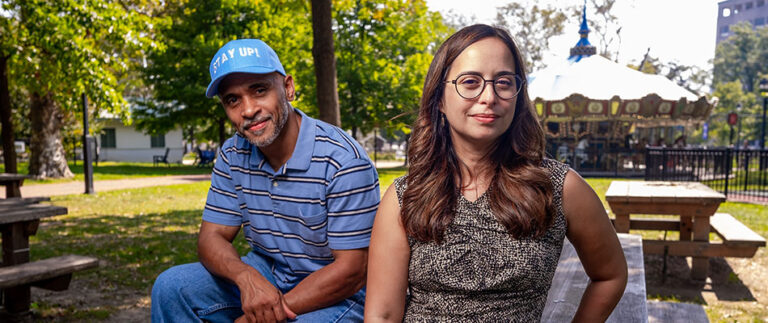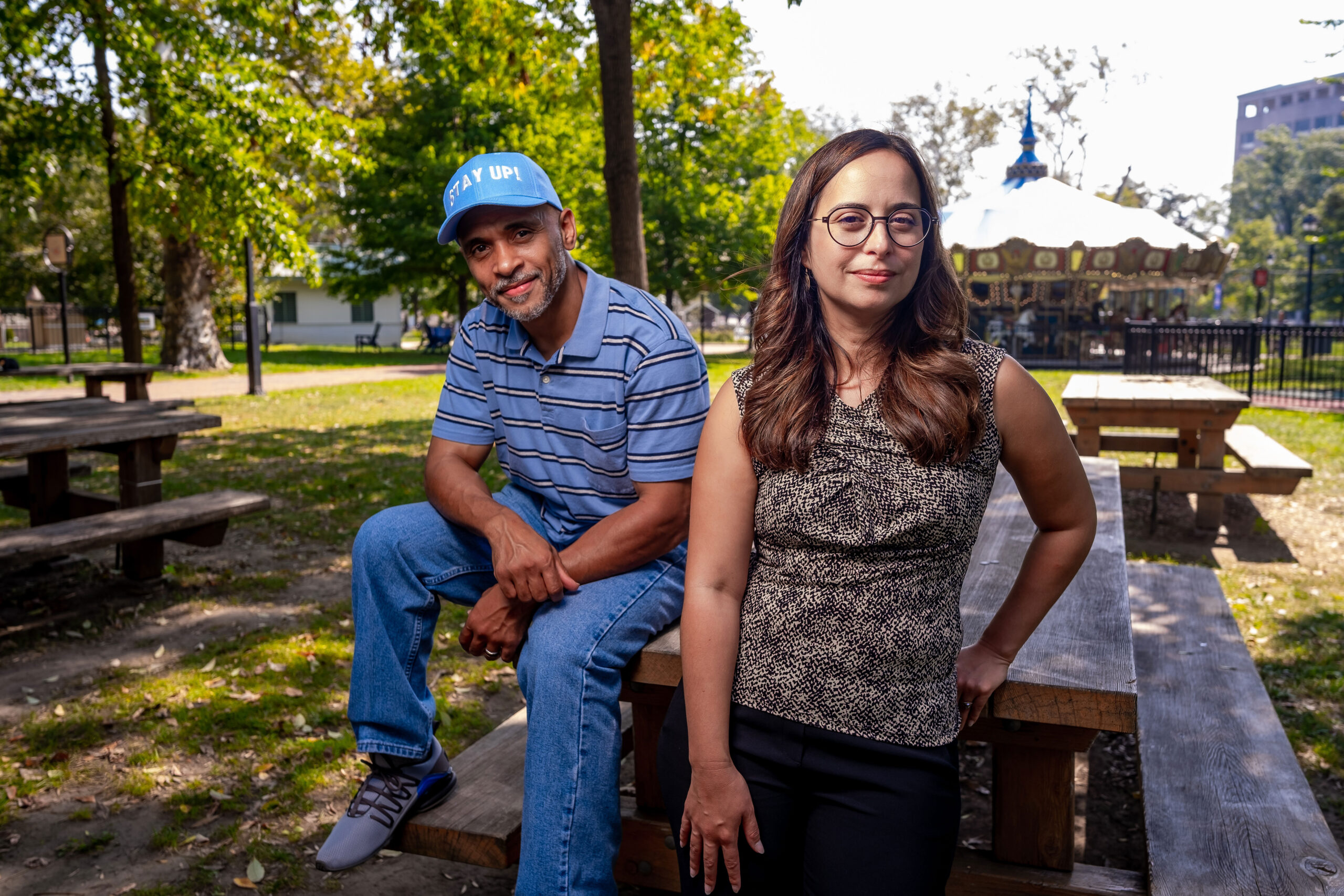
Kempis Songster with Rachel López. Photo Credit: Jeff Fusco.
Kempis Songster was a teenage runaway in the mid-1980s when his freedom came to an end. He’d left his home in Brooklyn a week before he completed the ninth grade and landed in Southwest Philadelphia, where he joined a Jamaican gang of street kids selling drugs out of a crack house. One night, a fight broke out. Songster recalls, “I ended up with blood on my hands that the next 30 years could never wash off.”
Songster was tried as an adult for murder and sentenced to life in prison without the possibility of parole. Though just 15, he was shipped off to Pennsylvania’s largest maximum-security prison, at Graterford, northwest of Philadelphia.
He had every reason to believe he would die in prison — but he got a rare second chance.
In 2017, at age 48, he was released after the U.S. Supreme Court ruled in Miller v. Alabama that automatically sentencing a child to life without parole violates the Eighth Amendment’s prohibition against cruel and unusual punishment, giving judges discretion to consider youthfulness in such cases. Songster is one of hundreds of juvenile lifers who have since been resentenced or paroled, including more than 520 in Pennsylvania alone.
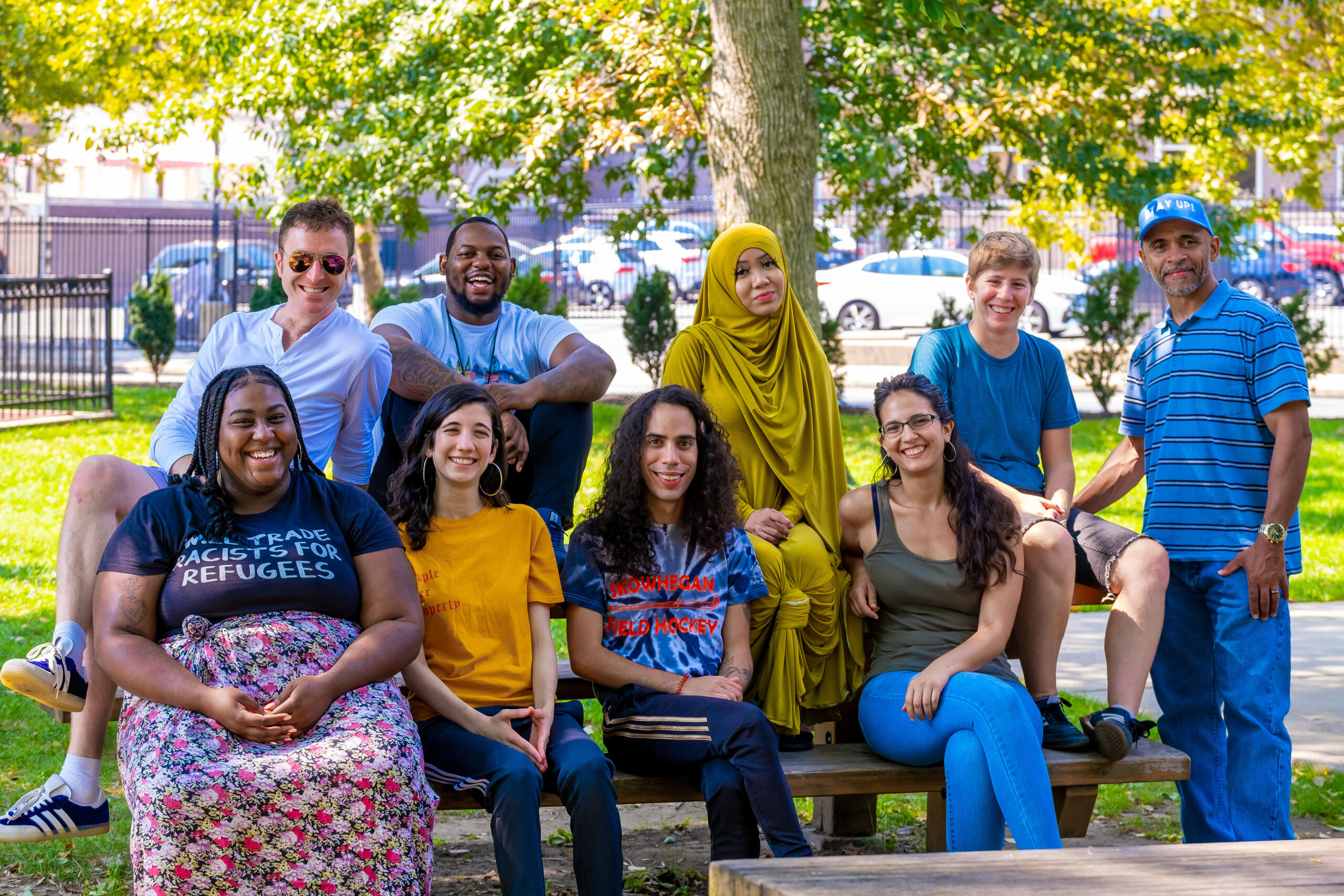
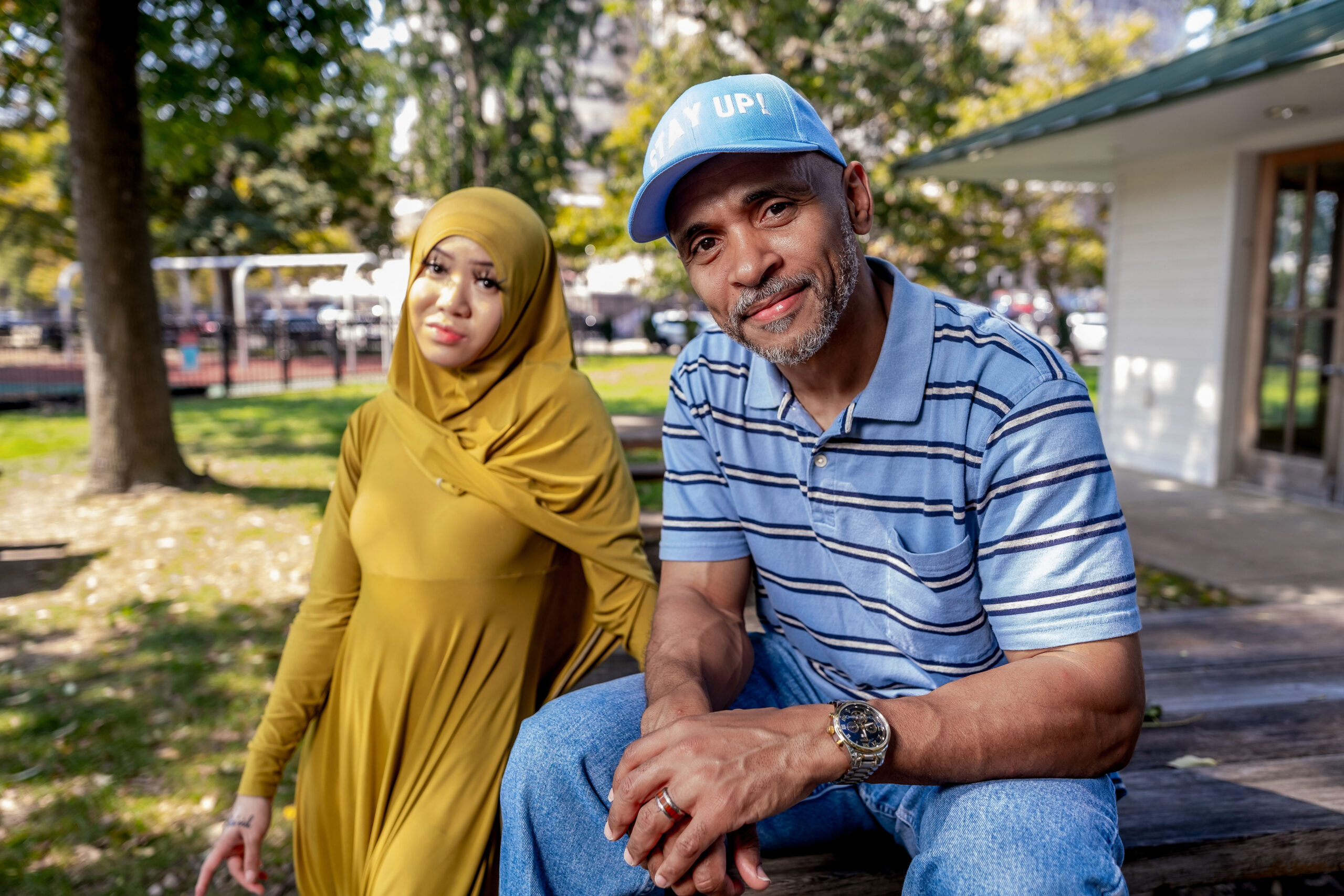

Songster meets regularly with members of his Healing Futures team. They are young people with personal experience with the justice system, some as former incarcerated juveniles, who facilitate meetings between charged youth who wish to make amends and their victims. Photo Credit: Jeff Fusco.
On the outside, he sought ways to atone for what years of scholarship, prayer and meditation had revealed were “the cosmic implications of what I had done.” He married, became a father and purchased a home. He worked first as an organizer for The Amistad Law Project, a West Philadelphia public interest law center that is working to end mass incarceration, and currently as the program director of Healing Futures, a restorative justice diversion program for the Youth Art & Self-Empowerment Project, in partnership with the Philadelphia District Attorney’s office. In his present work, he helps youth in the criminal justice system ameliorate the harms they’ve caused through dialogue with their victims.

Kempis “Ghani” Songster was a juvenile lifer until his release in 2017. He now works as program director of Healing Futures, a restorative justice diversion program in Philadelphia.
Lessons from his life figure prominently in a new law review article that he co-authored with another lifer who is still incarcerated, Terrell Carter, and with Rachel López, a Kline School of Law associate professor and a fellow at the Carr Center for Human Rights Policy at the Harvard Kennedy School.
“Redeeming Justice” was published in late 2021 in the prestigious Northwestern University Law Review.
Drawing on the lived experience of Songster and Carter, the authors argue powerfully that no one is irredeemable and therefore no one should be consigned to a life sentence without possibility of parole: “All humans have the capacity to forgive and be forgiven, to transform and be transformed, and the law should reflect these innate qualities — that all human beings have a right to redemption,” they write.
Their legal argument is a reading of the Eighth Amendment that would require a dramatic re-imagining of the U.S. criminal justice system, and that would bring the United States into step with international human rights trends.
The Advocate
The groundwork for this unusual collaboration was laid by López’s work as director of the Andy and Gwen Stern Community Lawyering Clinic, a pro bono service operating out of Drexel’s Dornsife Center for Neighborhood Partnerships at the border of the Powelton Village and Mantua neighborhoods on the northern edge of Drexel’s campus.
The clinic connects Kline legal students with neighbors and community members in need of advocacy and legal advice. Through these ties, López and Kline students became acquainted with Carter, who grew up in the nearby Mantua neighborhood. Carter is currently serving a life sentence in SCI Phoenix (Graterford’s successor prison), where he participates in a group that calls itself the Right to Redemption Committee.
The members are all lifers who share a common struggle to “find a path to redemption in the legal system that saw none,” as the authors put it. In spite of their legal status, the committee has long gathered regularly on the inside to help each other reach redemption through personal responsibility and making amends. Together, they developed a proposal for a human right to redemption.
Prior to the pandemic, López and her students regularly visited the prison to discuss topics related to criminal justice reform with the committee members.

Rachel López is an associate professor of law and director of Drexel’s Andy and Gwen Stern Community Lawyering Clinic. She has studied human rights and justice issues extensively both as a Harvard Kennedy School fellow and as a Fulbright Scholar, and from 2015 to 2019 she served as a commissioner on the Pennsylvania Sentencing Commission.
López, whose specialty is international human rights law, discovered through her research that the committee’s fundamental idea — that all people have the capacity for transformation and that this should be reflected in the law as a human right — is already present in international law. The European Court of Human Rights has asserted that “all prisoners, including those serving life sentences, must be offered the possibility of rehabilitation and the prospect of release if that rehabilitation is achieved.”
Life without parole has also been denounced by the Council of Europe and by the United Nations’ Human Rights Committee. As early as the 1970s, the Council concluded, “A crime-prevention policy which accepts keeping a prisoner for life even if he is no longer a danger to society is not compatible with modern principles on the treatment of prisoners.”
“The collaboration between our committee, Rachel, and her students was extremely beneficial,” says Carter. “They brought us a fresh perspective that was a little different, but no less important in the crafting of our ideas.”
For the young law students who attended, the meetings were a window into the power of lawyering on behalf of social justice. “A movement lawyer is an ally and partner to communities directly impacted by an issue,” says Reece McGovern, JD ’21, a recent graduate who was part of those conversations. “Rather than take the lead on strategic decision-making, movement lawyers look to those communities for direction and expertise on the issues at hand.”
When the pandemic hit, however, the prison locked down and no one, not even lawyers, could visit. López decided to turn the discussions she’d had with the committee into a law review article. She wrote it individually with Carter and Songster, who had been a leader of the committee before his release.
The project was slow and, for Carter, came with a toll. Prison phone calls are limited to 15 minutes, and correctional personnel take days to process prisoners’ electronic mail, which is monitored and requires the purchase of “credits.” But Carter was determined. “Seeing people go home who were similarly situated has renewed my hope that there can be an end to a never-ending condemnation,” he says.
The Legal Argument
The concept of criminal rehabilitation is not foreign to American soil. Prison reformists in Philadelphia opened Eastern State Penitentiary in 1829 in the belief that penitence was possible behind bars, and they designed their building in the hope of inspiring spiritual growth.
But that kind of sentiment is largely absent from modern American jurisprudence, which has more people serving life than any other country in the world.
In the later part of the 20th century the United States embarked on a campaign of mass incarceration that has increased the number of people serving life sentences fivefold since 1984 to more than 200,000. Today, one out of every seven prisoners is incarcerated for life, according to a recent report by The Sentencing Project, a criminal justice reform group based in Washington, D.C.
In a nation of mass incarceration, Pennsylvania imprisons even more than most. Adults convicted of either first- or second-degree murder in the state receive mandatory life without parole sentences, and the state categorically denies parole to those sentenced to life. Pennsylvania has the second-highest number of prisoners of any state who are condemned to die in prison, totaling more than 5,000 women and men. The vast majority, 72%, are black or brown, and they are increasingly elderly.
The authors of “Redeeming Justice” criticize the United States’ “retributivist approach” to criminal punishment, steeped in the Old Testament invocation of “an eye for eye,” as being out of step with international human rights law. They maintain that a criminal sentence, imposed decades ago, should not persist indefinitely with the same force.
They point to Supreme Court precedent that underscores how the concept of human dignity informs legal analysis when courts determine whether punishment is cruel and unusual. Linking case law to human rights trends grounded in the concept of human dignity, they argue that punishments should be “reviewed regularly to assess the evolving justifications for confinement” rather than frozen in time.
At the heart of their argument is the prohibition against cruel and unusual punishment enshrined in the Eighth Amendment of the Constitution.
In recent years, a line of cases have successfully used the Eighth Amendment to argue for leniency in how young prisoners are sentenced — all of which culminated, in 2012, in the landmark Miller v. Alabama decision by the Supreme Court upholding that “children are constitutionally different from adults for purposes of sentencing.” Mandatory life sentences, the Court concluded, amount to cruel and unusual punishment for juveniles, who have “greater capacity for change.”
Then in 2016, Montgomery v. Louisiana made Miller’s holding retroactive, allowing hundreds of juvenile lifers to be resentenced and eventually released. Like Songster, the vast majority have rebuilt their lives as responsible citizens. A 2020 study by Montclair State University found recidivism was just 1.14% among the 174 juvenile lifers released up to that point because of the Miller ruling.
“Redeeming Justice” takes the argument further still. The co-authors argue that incarcerated people of any age have the right to a second chance, claiming that “the capacity for redemption is an innate human characteristic.”
Alex Geisinger, associate dean for faculty development and research at the Kline School of Law, calls the article groundbreaking. “Unlike traditional legal scholarship, which is often written at a high level of abstraction by legal ‘experts,’ Redeeming Justice is informed by experience,” he says. “Two of its authors were sentenced to life without parole and are living proof of redemption — it is their stories that animate the article’s compelling case for legal recognition of such a right.”
The Incarcerated
For Carter, the struggle is personal. The Miller ruling gave him and other older lifers who’ve tried to redeem themselves behind bars hope that they can escape dying in prison, or what Carter calls “death by incarceration.”
Once, Carter says, he was a selfish 22-year-old whose world was governed “by a 48-hour time frame in which I was driven by instant gratification.” One night, high on drugs, he caused someone’s death. “After being found guilty and condemned to die behind penitentiary walls, I was driven by a desperate need to know why,” he says.
As Songster had also done, Carter spent years reflecting. “It took a Herculean amount of self-honesty for me to come to grips with the fact that I was the cause of an irreparable harm because my in-the-moment decisions blinded me to the possible negative consequences of my actions,” he says. Over time, he obtained a bachelor’s degree from Villanova University, wrote three novels and a book of essays, provided hospice care to elderly prisoners, and worked with numerous groups that operate inside and outside of prison walls. In fall 2021, he enrolled in an online MFA program through Drexel.
But Pennsylvania’s mandatory life sentence means that “regardless of circumstances, who you have become, no matter how sorry you are, no matter all of the good work you have achieved, you can never be anything other than your worst actions,” says Carter, who has been incarcerated for 29 of his 52 years.
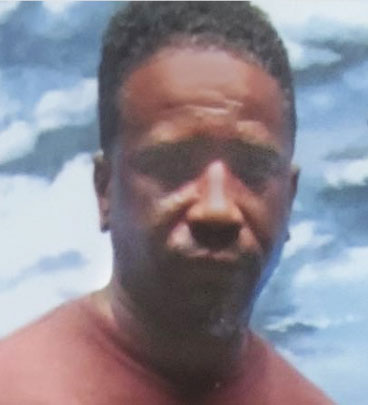
Terrell Carter, pictured here in a photo from his Facebook page, is currently serving a life sentence without parole in Pennsylvania.
In 2011, he cofounded the Right to Redemption Committee inside Graterford with a group of other men. At that time, the Miller ruling hadn’t yet come down, and morale was low, as men watched fellow prisoners die of sickness and old age in a fate that prefigured their own.
Carter says the concept of redemption that emerged from that committee saved him. “It saved me from this narrowly defined existence of ‘us vs. them,’ of vengeance masquerading as justice,” he writes. “The right to redeem oneself has become as precious to me as the right to live free…. It has awakened in me this burning desire to right my wrongs, to give back to the community that I so selfishly have taken so much from.”
He believes that he and others serving life without parole have the capacity to transform, and with the support of López and the Stern Community Lawyering Clinic, he has applied for a commutation of his sentence so that he can qualify for parole hearings.
The authors have a powerful ally in Pennsylvania’s Lieutenant Governor, John Fetterman. He serves as Chairman of the Board of Pardons, which decides whether to grant commutations of sentences in the state with a panel made up of the state attorney general, a corrections expert, a psychiatrist and a victim representative.
Fetterman has said that life without parole should be abolished for second-degree (felony) murder, which is when someone is inadvertently killed in the act of committing a felony. If he could, he says, he would assess all those currently serving life to determine the appropriateness of the sentence.
“Pennsylvania literally spends $3 billion per year incarcerating people and less than $1 million on second chances and redemption,” says Fetterman.
Since Fetterman took office in 2019 and joined the Board of Pardons, there has been a steep uptick in clemency, including the commutation of 17 life sentences. But it takes years to be considered and to meet the unanimity threshold.
López is aware that many judges, prosecutors and victims’ rights advocates do not accept that redemption is possible for those who take a life. However, she and her coauthors hope to influence how the legal community thinks about life sentencing and human rights. “We believe that all human beings have the capacity for change,” she says. “Whether they exercise that capacity is another matter.”
“The beauty of law review articles is that in them we can imagine a different reality, one where the law is stretched to imagine new possibilities,” López continues. “It is about changing the way that society understands the law and its purposes.”
The Court
Given the current makeup of the Supreme Court, the examples set by men by like Songster and Carter may have little bearing, at least in federal law. In April, the conservative Majority explicitly rejected an argument that used the language of redemption in Jones v. Mississippi.
The case was brought by Brett Jones, who was sentenced to life without parole for stabbing his grandfather to death when he was 15. Contending that he is a different person now than he was, Jones argued that precedent set in Miller v. Alabama and Montgomery v. Louisiana required the judge who sentenced him to take into account not only his youth, but also whether he was beyond rehabilitation.
The 6-3 Majority opinion disagreed, and further signaled that the Court’s decades-long trend toward mercy has reached a limit.
Justice Brett Kavanaugh, writing the opinion, reiterated that the Eighth Amendment does not prevent a judge from sentencing a child under 18 to life without parole as long as life without parole sentences aren’t mandatory for juveniles. Further, in a separate opinion, Justice Clarence Thomas hinted that Montgomery, which made the release of Songster and other lifers possible, should be overruled, calling it “a ‘demonstrably erroneous’ decision worthy of outright rejection.” (Emphasis added.)
Jones makes the argument in “Redeeming Justice” even more timely, says López.
She notes that the Court urged states to develop their own tests for when to impose life without parole, which gives states broad discretion to adopt their own limits. She’s hopeful they will be swayed by a redemptive approach.
“States still have the power to redeem justice in a way that recognizes and values human dignity,” she says.
About the Author: Cheri Brooks is a lawyer who represents indigent defendants at the Defender Association of Philadelphia. She was an adjunct professor at Drexel’s Philosophy Program, the Kline School of Law, and other institutions, including teaching incarcerated students through the Inside-Out Prison Exchange Program.


